![]()
![]()
![]()
Use LEFT and RIGHT arrow keys to navigate between flashcards;
Use UP and DOWN arrow keys to flip the card;
H to show hint;
A reads text to speech;
27 Cards in this Set
- Front
- Back
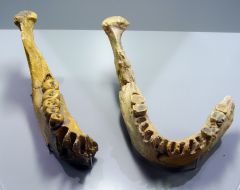
|
H. erectus lower jaw: |
|
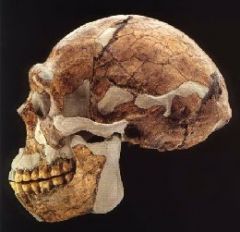
|
H. erectus side view: |
|
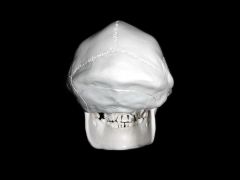
|
H. erectus posterior view: |
|
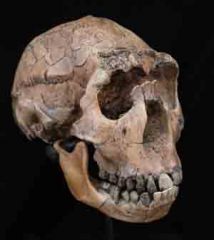
|
H. erectus face: |
|
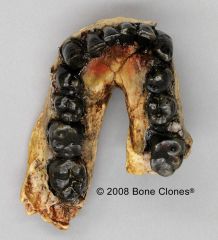
|
H. habilis lower jaw: |
|
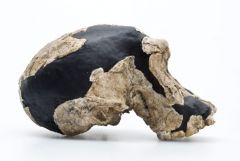
|
H. habilis side view: |
|
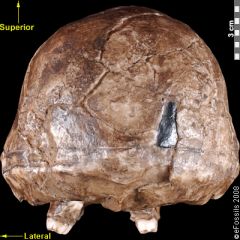
|
H. habilis posterior view: |
|
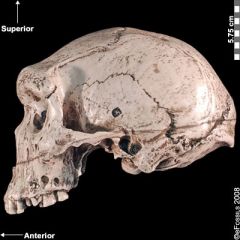
|
H. hiedelbergensis side view: |
|
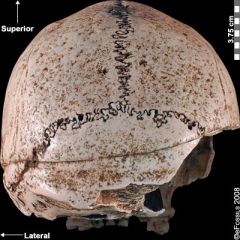
|
H. hiedelbergensis posterior view: |
|
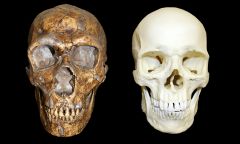
|
Left: H. neanderthalensis, Right: H. sapiens
Compare the sizes of the cranial vault. The H. neanderthalensis is larger and a more prominent brow ridge. Also note the larger nasal aperture. |
|
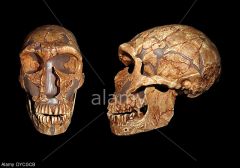
|
H. neanderthalensis side and front view
Note a lack of mental eminence and the cranial vault is less round than a H. sapiens'. |
|
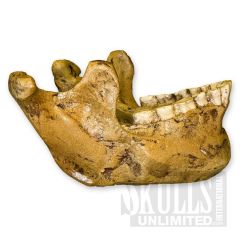
|
H. neanderthalensis jaw
H. neanderthalensis is the only Homo that has retromolar gap. |
|
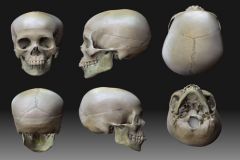
|
H. sapiens skull
Note the shape of the cranial vault, the relatively small teeth, the presence of a mental eminence, and subtle brow ridge. |
|
|
Sagittal Keel |
A thickening of bone on part or all of the midline of the frontal bone.
|
|
|
Supraorbital Torus |
Or brow ridge, refers to a bony ridge above the eye sockets.
|
|
|
Occipital (Nuchal) Torus |
A thickened bony prominence extending some or across the back of the head. |
|
|
Supraorbital Sulcus |
A broad depression, or groove, between the brow ridges and frontal bone.
|
|
|
Nasal Aperture |
The width of the nasal opening.
|
|
|
Mental Eminence |
A projecting mandibular bone, or the presence of a chin. |
|
|
What's the difference between Oldowan and Acheulean tools? |
Oldowan tools are the flakes of rocks, used for meat, associated with H. habilis. Acheulean tools were used by H. erectus and later hominids, the to old was the core of a stone and would take significant strength and mental capacity for its creation.
|
|
|
H. erectus |
-First hominid species to spread out of Africa -Associated with more sophisticated tools and technological firsts, like using fire and the "soft hammer" technique |
|
|
H. habilis |
-Appears 2.4-2.3 Ma
~roughly same time as Paranthropus ~found with Paranthropus fossils -Found in Olduvai Gorge, Tanzania -AKA "Handy Man" ~was found with tools and first hominid associated with tool making. -Attained some Australopithecus features |
|
|
H. hiedelbergensis |
-Replaces H. erectus in Africa and Europe around 600-800 Ka
~fossils date from 600,000-250,000 years ago -Displays several intermediate features between H. erects, H. neanderthalensis, and H. sapiens ~sometimes more resemble H. erectus, sometimes more modern -Evolves into H. neanderthalensis in Europe -Evolves into modern human in Africa |
|
|
H. neanderthalensis |
-Distinct group known entirely in Europe, W. Asia, and (maybe) Siberia
~the earliest fossils are ~300,000 years old ~they go extinct 25-30,000 years ago -Their existence overlaps with H. sapiens (that's us) in Europe -Their distinctive morphology that may be adaptive for extreme cold of Ice-Age Eurpope |
|
|
H. sapiens
|
-20,000 years ago present in Africa -SW Asia by 90,000 years ago -E Asia and Australia by 50,000 years ago -Europe around 35,000 years ago -The Americas aprox. 13,000 years ago |
|
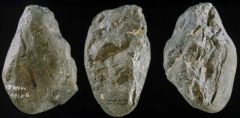
|
Oldowan tools:
-Associated with H. habilis -Displays the "hard hammer" technique ~"hard hammer" technique: banging rocks together -One would make these with the intention to use the flakes and not cores |
|
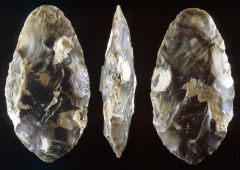
|
Acheulean tools:
-Associated with H. erectus and later hominids -Displays the "soft hammer" technique ~"soft hammer" technique: a softer rock is used to shape the core -Grew to be more sophisticated over time -Tool maker had to actively plan during the making of the tool ~takes a lot of strength ~the intent was to use the core |

